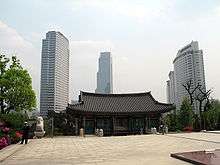Bongeunsa
| Bongeunsa | |
 Part of Bongeun Temple | |
| Korean name | |
|---|---|
| Hangul | 봉은사 |
| Hanja | 奉恩寺 |
| Revised Romanization | Bongeunsa |
| McCune–Reischauer | Pongŭnsa |
Bongeunsa is a Buddhist temple located in Samseong-dong, Gangnam-gu in Seoul, South Korea.[1] It was founded in 794 during the reign of King Wonseong by the monk Yeon-hoe (Hangul: 연희), then the highest ranking monk of Silla, and originally named Kyongseoungsa (Hangul: 견성사; Hanja: 見性寺). It is located on the slope of Sudo Mountain, across the street from the COEX Mall.
History

During the Joseon Dynasty, Buddhism in Korea was severely supressed. However, The temple began to be known as Bongeunsa when was reconstructed in 1498 under the patronage of a Joseon Queen. The term Bongeunsa means the act of honoring the king, which here can be undeestood as taking the form of praying for king Seongjong's eternal life. [2]
With the support of Queen Munjeong, who revived Buddhism in Korea for a short time in the mid-16th century, it became the main temple of the Korean Seon (Zen) sect of Buddhism from 1551 through 1936.[3] Monk Bo-wu was appointed head of the temple in 1548 by Queen Munjeong but was killed soon afterwards as the anti-Buddhist factions regained dominance in Korea towards the end of Queen Munjeong's rule. From 1552-1564 it was the center of the Buddhist National Exam.
A fire in 1939 destroyed most of the buildings, and other parts of the temple were destroyed during the Korean War. Fortunately, one of the very few halls which escaped destruction during the Korean War continues to hold the woodblock carvings of the Flower Garland Sutra, 봉completed in 1855 by monk Young-ki The temple has undergone many repairs and renovations, and is now once again a large, thriving complex. The reconstruction efforts are being waged even today.
Bongeunsa under Japanese rule
Bongeunsa was made one of Korea's 14 major temples in 1902. During the Japanese occupation the temple became the headquarters of 80 smaller Buddhist temples around Seoul. In 1922 and 1929, the head monk Cheong-ho saved over 700 people from drowning in the Han river, an act that inspired a monument of recognition. After colonial rule Bongeunsa became subordinate to the Jogye order, the largest Buddhist sect in Korea.
Tourism
The temple is a notable tourist destination, offering "Temple Stay Program" in which visitors can lead the life of a monk for a few hours.
The area on the main street from the Temple to Park Hyatt Hotel, has a large concentration of vegetarian and other upscale restaurants that serve Korean cuisine with a modern twist.[4]
Gallery
-

dancing performance at the Temple
-

lanterns at the Temple during Buddha's birthday in 2007
-

View of skyline from Bongeunsa
See also
- List of Buddhist temples in Seoul
- Korean Buddhism
- Korean architecture
- Korean Buddhist temples
- List of Korea-related topics
- Japanese occupation of Korea
References
- ↑ Rachel Sang-hee Han; Frances Cha (17 December 2012). "13 things you've got to do in Seoul". CNN Travel. Retrieved 26 February 2013.
- ↑ Yoo, Myeong-jong (2009). Temples of Korea. Myeong-jong. p. 140.
- ↑ "buddhapia.com". Archived from the original on 2010-06-08. Retrieved 2010-06-04.
- ↑ Cho Jae-eun; Chang Hae-won; Choung Hyuk-min (3 August 2011). "Feast of food in a concrete jungle". Joongang Daily. Retrieved 27 January 2013.
External links
| Wikimedia Commons has media related to Bongeunsa. |
- Bongeun (Official site)
- Asian Historical Architecture: Bongeunsa Temple
Coordinates: 37°30′56″N 127°03′26″E / 37.51556°N 127.05722°E